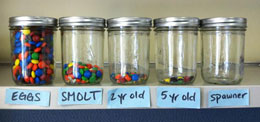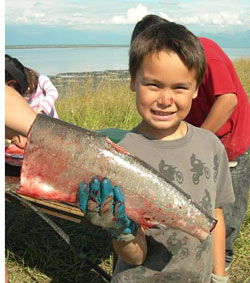Alaska Fish & Wildlife News
October 2012
Science & Salmon Education
Why are Commercial Fisheries Important?

Alaska’s commercial fisheries are diverse and valuable. Across Alaska, thousands of vessels large and small harvest a variety of finfish and shellfish. Yet many Alaskans lack an understanding of commercial fisheries in Alaska - and of salmon management - and why both are important to all Alaskans.
Division of Commercial Fisheries staff are working to fill this information gap by increasing awareness of science, salmon, and commercial fisheries in Alaska.
The division has no education associates or fisheries biologists or technicians dedicated solely to education and outreach programs as other divisions do. However, many Commercial Fisheries staff have personal interests that overlap with their work and have been involved in education and outreach programs and workshops while representing the division with team spirit. Such programs and events in Southcentral include the Becoming an Outdoors Woman (BOW) workshops, Outdoor Youth Days, local elementary school math and science nights, educational salmon camps, classroom presentations, and joint events with other divisions like the Sport Fish Division’s Ray Troll-painted mobile aquatic classroom (MAC) at the Great Alaskan Sportsman’s show, the Governor’s picnic, and the Alaska State Fair. And that’s just the stuff folks in Anchorage do.
Commercial Fisheries staff at headquarters in Juneau and in regional and field offices support other great programs and events ‘round the state. These include talking with public and helping staff booths at Alaska Federation of Natives (AFN) conferences, university and high school career fairs, trade shows like CommFish in Kodiak and Pacific Marine Expo in Seattle, and presenting at Sea Grant/Marine Advisory Programs such as the Young Fishermen’s Summit.
And as if all that wasn’t exciting enough, 2011 marked a new beginning for the Division of Commercial Fisheries, the formal development of an education program. Specifically, a science education outreach program targeting fishermen and other community members in the Alaskan portion of the Yukon River. Biologists Heather Leba and Stephanie Schmidt submitted a proposal that led to a grant from the Yukon River Panel Restoration and Enhancement fund and got the program rolling.

The goal is to advance information, increase awareness of salmon topics, and enable greater community understanding and participation in management of Yukon River salmon and their habitat. The workshops were designed to be interactive and facilitate knowledge sharing between participants and workshop leaders. With declines in Yukon River salmon runs, specifically Chinook salmon, division managers and research staff wanted to provide a forum for sharing relevant scientific and traditional knowledge to form hypotheses that might explain the declines. By sharing this knowledge and promoting discussion about Yukon River salmon, scientists and fishermen help keep both groups informed and build partnerships.
For the initial year of the program, two topics were chosen for lesson development. Freshwater life history of salmon and marine life history of salmon. Lessons were created using posters depicting the complex factors impacting salmon, and jars of M&M candies representing salmon eggs at each stage of the life cycle. To illustrate the mortality rate at each life history stage biologists used one jar full of M&M’s - representing about 4,000 eggs, typical of an average-sized female salmon, and one jar with a single M&M - the one egg of the original 4,000 that survives to adulthood and makes it back to the spawning grounds,
Together the jars of candy eggs and posters help biologists explain the five life history stages of Pacific salmon and highlight common factors, identify the potentially most important factors, and discuss which factors we have control over as stakeholders and managers. Each workshop began with a description of what the M&M jars represented and the discussion was framed around one question: “What is happening at each life history stage that is causing us to go from approximately 4,000 eggs to just one individual surviving to the spawning grounds?”
Biologists asked the participants to reflect on their experiences and traditional knowledge and describe all the potential factors that affect salmon at each life history stage. At the conclusion of each workshop biologists emphasized the number of factors that impact salmon at each stage and stressed the complexity of the issues for scientists, managers, and fishermen alike.

These workshops were presented at user group meetings in Galena, Fairbanks, and Anchorage early in 2012 and participant feedback was encouraging; these interactive lessons and discussions do help foster a better understanding of the salmon life cycle in Yukon River communities.
If funding is awarded for 2012/2013 Commercial Fisheries Yukon staff will modify these lessons to target K-12 students using standards-based science education modules. These future lessons would include topics related to fish biology, genetics, habitat ecology, current scientific research, the use of sonar in research and scientific methodology of Yukon River research projects. Through partnerships with local community schools the lessons would be presented at three Yukon River K-12 schools. Forming partnerships with other organizations like the Tanana Chiefs Conference (TCC), University of Alaska Fairbanks (UAF) GK-12 program, and UAF Sea Grant will allow the program to further build on the foundation, expand the number of participants, and reach a wider range of villages.
The goal is that knowledge of commercial fisheries, salmon management, and even specific research projects will provide a broader context for understanding the challenges associated with managing and protecting our valuable salmon resources. Information gained by young people in the classroom will ideally be put to use as they become fishers themselves. The intention is that knowledge gained from these lessons will help empower students, both young and old alike, to become more engaged future stakeholders in Yukon River fisheries.
The benefits of this project and all ADF&G education and outreach programs to their communities and the department are many and have the potential to extend well into the future in ways that cannot be yet imagined. By providing these commercial fisheries information and education opportunities we are not only educating Alaskans, we are preparing them to serve as caretakers of a shared resource. We all have one thing in common, it’s salmon.
Katie Sechrist is an information officer with the Division of Commercial Fisheries.
Subscribe to be notified about new issues
Receive a monthly notice about new issues and articles.
